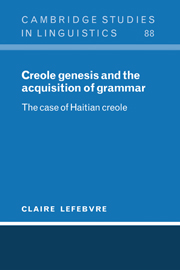Book contents
- Frontmatter
- Contents
- Tables
- Preface
- Abbreviations
- 1 The problem of creole genesis and linguistic theory
- 2 Cognitive processes involved in creole genesis
- 3 The research methodology
- 4 Functional category lexical entries involved in nominal structure
- 5 The preverbal markers encoding relative Tense, Mood and Aspect
- 6 Pronouns
- 7 Functional category lexical entries involved in the structure of the clause
- 8 The determiner and the structure of the clause
- 9 The syntactic properties of verbs
- 10 Are derivational affixes relexified?
- 11 The concatenation of words into compounds
- 12 Parameters
- 13 Evaluation of the hypothesis
- 14 Theoretical consequences
- Appendices
- Notes
- References
- Index of authors
- Index of languages and language families
- Index of subjects
11 - The concatenation of words into compounds
Published online by Cambridge University Press: 23 November 2009
- Frontmatter
- Contents
- Tables
- Preface
- Abbreviations
- 1 The problem of creole genesis and linguistic theory
- 2 Cognitive processes involved in creole genesis
- 3 The research methodology
- 4 Functional category lexical entries involved in nominal structure
- 5 The preverbal markers encoding relative Tense, Mood and Aspect
- 6 Pronouns
- 7 Functional category lexical entries involved in the structure of the clause
- 8 The determiner and the structure of the clause
- 9 The syntactic properties of verbs
- 10 Are derivational affixes relexified?
- 11 The concatenation of words into compounds
- 12 Parameters
- 13 Evaluation of the hypothesis
- 14 Theoretical consequences
- Appendices
- Notes
- References
- Index of authors
- Index of languages and language families
- Index of subjects
Summary
Compound words are syntactic atoms, i.e. they constitute islands to or from which no lexical material can be inserted, deleted or moved out by syntactic rules (see e.g. Allen 1978; Di Sciullo and Williams 1987). All the compounds discussed in this chapter are such syntactic atoms. Furthermore, the literature on generative morphology generally assumes that the lexicon lists idiosyncratic information about morphemes (see e.g. Lieber 1980, 1992; Sproat 1985; Di Sciullo and Williams 1987). Consequently, compounds are listed in the lexicon only if their properties cannot be predicted from the properties of their constituents and from the word structure rules. Thus, in contrast to idiosyncratic or listed compounds, productive or regular compounds do not constitute lexical entries, and, thus, they do not undergo relexification. The productive compounds of Haitian creole are therefore the result of the concatenation of simple lexical entries. As will be seen in this chapter, however, the semantics and structure of many Haitian compounds parallel those of Fongbe compounds and contrast with French, showing that the creators of Haitian used the principles of their own grammar in concatenating simplexes into compounds. Furthermore, concepts expressed by compounds in Haitian and Fongbe are often expressed by simplexes in French. The fact that the French simplexes did not make their way into Haitian is argued to follow from the relexification hypothesis: the creators of Haitian had no such lexical entries to relexify. The comparison of Haitian, French and Fongbe compounds presented below addresses the topic from three points of view: semantics, word order and types of compounds.
- Type
- Chapter
- Information
- Creole Genesis and the Acquisition of GrammarThe Case of Haitian Creole, pp. 334 - 348Publisher: Cambridge University PressPrint publication year: 1999



